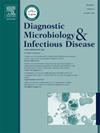经阴道手术后阴道菌血症:辅助生殖技术中一种罕见的并发症
IF 2.1
4区 医学
Q3 INFECTIOUS DISEASES
Diagnostic microbiology and infectious disease
Pub Date : 2025-06-06
DOI:10.1016/j.diagmicrobio.2025.116947
引用次数: 0
摘要
背景:凡氏阴道菌群常见于阴道菌群,与细菌性阴道病有关,但很少引起侵袭性感染。很少有阴道F.菌血症的病例报道,主要是在怀孕或妇科手术的背景下。病例一名40岁妇女,经阴道辅助生殖技术手术两周后出现发烧和右下腹疼痛。她没有细菌性阴道病的症状。磁共振显示一个9厘米的输卵管卵巢肿块。血液培养和手术标本培养出革兰氏阳性球菌,后来被鉴定为阴道f。患者经右侧输卵管卵巢切除术和头孢美唑治疗7天后恢复。结论本病例表明阴道F.阴道菌可引起经阴道手术后的严重感染,即使在没有细菌性阴道病症状的情况下。临床医生应考虑阴道F.作为妇科手术后感染的潜在病原体,特别是当厌氧血培养呈阳性时。本文章由计算机程序翻译,如有差异,请以英文原文为准。
Fannyhessea vaginae bacteremia following transvaginal procedures: A rare complication in assisted reproductive technology
Background
Fannyhessea vaginae is commonly found in vaginal flora and associated with bacterial vaginosis, but rarely causes invasive infections. Few cases of F. vaginae bacteremia have been reported, primarily in the context of pregnancy or gynecological procedures.
Case
A 40-year-old woman presented with fever and right lower abdominal pain two weeks after undergoing transvaginal procedures for assisted reproductive technology. She had no symptoms of bacterial vaginosis. Magnetic resonance imaging revealed a 9 cm tubo-ovarian mass. Blood cultures and surgical specimens grew gram-positive cocci, later identified as F. vaginae. The patient recovered following right salpingo-oophorectomy and seven days of cefmetazole therapy.
Conclusion
This case demonstrates that F. vaginae can cause serious infections following transvaginal procedures, even in the absence of symptoms of bacterial vaginosis. Clinicians should consider F. vaginae as a potential pathogen in post-gynecological procedure infections, particularly when anaerobic blood cultures become positive.
求助全文
通过发布文献求助,成功后即可免费获取论文全文。
去求助
来源期刊
CiteScore
5.30
自引率
3.40%
发文量
149
审稿时长
56 days
期刊介绍:
Diagnostic Microbiology and Infectious Disease keeps you informed of the latest developments in clinical microbiology and the diagnosis and treatment of infectious diseases. Packed with rigorously peer-reviewed articles and studies in bacteriology, immunology, immunoserology, infectious diseases, mycology, parasitology, and virology, the journal examines new procedures, unusual cases, controversial issues, and important new literature. Diagnostic Microbiology and Infectious Disease distinguished independent editorial board, consisting of experts from many medical specialties, ensures you extensive and authoritative coverage.

 求助内容:
求助内容: 应助结果提醒方式:
应助结果提醒方式:


